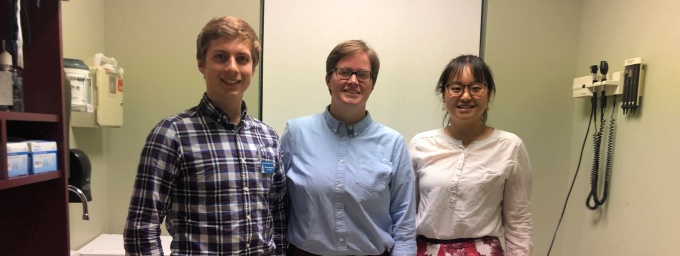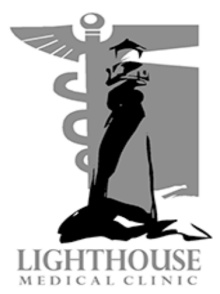
Left to right: Medical student Thomas Listopadzi with UB School of Law student attorneys Colleen Roberts and Keyi Yang at the Lighthouse Clinic.
Law students join the team at free medical clinic
A first-of-its-kind collaboration between UB’s premier professional schools is bringing a new holistic perspective to health care for residents of Buffalo’s East Side.

The joint effort has court-certified student attorneys enrolled in the School of Law’s Health Justice Law & Policy Clinic working alongside UB medical students in the student-run Lighthouse Clinic. The goal is to identify and address life issues that the health clinic’s patients are facing, and provide remedies through the legal system.
The collaboration, says Danielle Pelfrey Duryea, who directs the law school clinic, grows out of “a recognition that 60 to 80 percent of an individual’s health is affected by factors other than biology and genetics – what neighborhood you were born in and grow up in, where you go to school, the food you have access to, the housing you live in.”
UB medical students have operated the Lighthouse Clinic, housed on William Street, since 2001, and its offerings have expanded to include specialties such as dermatology, gynecology and lab testing, as well as providing free primary care. It’s open every Wednesday evening, treating as many as two dozen patients in that time.
The law students’ participation adds an important new facet to the care patients receive. New screening questions help to surface legal issues they might be facing, and that information becomes part of the treatment discussion.
“We’re part of the care team, right there when all the information is being shared,” Pelfrey Duryea says. “And we’re teaching the medical students what to look for, what kinds of questions to ask, like 'Are you having trouble paying the rent?' or 'How are the conditions in your rental housing?' Now they ask every patient, 'What is the biggest non-medical factor affecting your health?' We’re helping them not only to be aware that there are non-medical determinants of health, but also how to engage those and address them.”
It’s a model even more fully integrated than LegalCare at Roswell Park, the medical-legal partnership the Health Justice Law & Policy Clinic runs at Roswell Park Comprehensive Cancer Center. But the patients’ needs are generally different. At Roswell Park, Pelfrey Duryea says, the clinic’s six students typically help patients with advance health care planning, powers of attorney, and simple wills, as well as public benefits and employment discrimination issues stemming from their illnesses. At the Lighthouse Clinic, “we’re seeing a very different mix of issues, and our students are loving it. There’s something really energizing about how fast-paced things are there, and they love working directly with the other students.”
Thomas Listopadzki, a first-year medical student who serves as the clinic’s administrative coordinator and one of a dozen medical student managers, says Lighthouse started in a church basement and has evolved. “Over the years we’ve been around, we’ve integrated a lot of different services,” he says. “Since the law school has become involved (on April 17), they’ve handled at least five or six different cases, and that’s five or six more people than we’ve been able to help with aspects of their life outside of their medical needs.”
Listopadzki, who worked in a hospital emergency room before entering medical school, says it was the norm in that setting for other professionals such as social workers and physical therapists to be involved in patient care. The Lighthouse collaboration, he says, reflects that model.
Law student Colleen Roberts, who is graduating this year after spending three semesters as part of the Health Justice Law & Policy Clinic, was instrumental in organizing the Lighthouse collaboration. She says that beyond the community service the law students are able to provide, it’s helpful to be able to take on the real-life challenges that arise.
“Some problems are solved very quickly,” Roberts says. “We can offer legal information, and sometimes that’s all folks need to move forward. We will provide ongoing representation for some people, but we can also connect them to one of our legal aid partners or even a private attorney if necessary.”
But, she says, the students – working under a practice order – can be a significant source of help in a variety of situations. That includes helping clients with their appeals after they’re turned down for Medicaid or another public benefit; assisting in landlord-tenant disputes or housing rights issues; and addressing other stressors covered by family law or employment law.
“The opportunity to practice, with supervision, before finishing law school is really helpful,” Roberts says, “and getting to work with patients and community partners, and seeing how legal tools can be used to improve health, has been great.”
“I’m so happy with the partnership, the way the medical students have totally embraced it and take seriously how to integrate law into that setting in a meaningful way, and in a way that works with the flow of patients,” Pelfrey Duryea says. “They’re already coming back to us and saying thanks.”